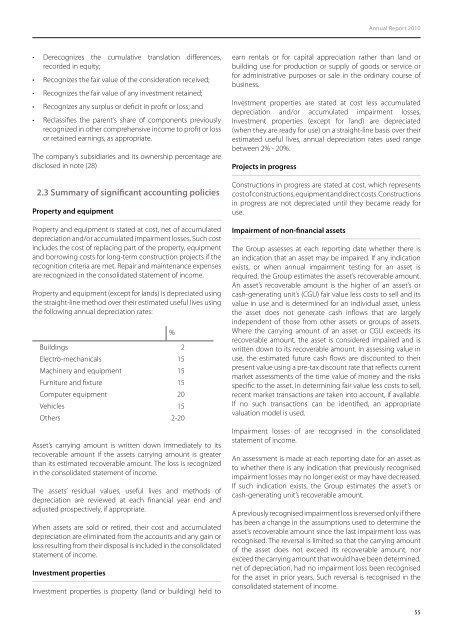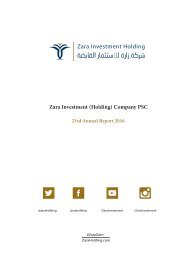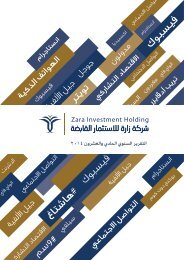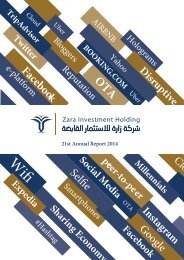ZaraAnnual-English2010
You also want an ePaper? Increase the reach of your titles
YUMPU automatically turns print PDFs into web optimized ePapers that Google loves.
Consolidated Financial Statements | Notes To The Consolidated Financial Statements December 31, 2010 Annual Report 2010<br />
Available for sale financial assets<br />
These are initially recognized at cost, being the fair value of<br />
consideration given including directly attributable transaction<br />
costs and subsequently re-measured at fair value. Fair value<br />
changes are reported as a separate component of equity<br />
until the investment is derecognized or the investment is<br />
determined to be impaired. On derecognizing or impairment<br />
the cumulative gain or loss previously reported as equity, is<br />
included in the consolidated statement of income<br />
Available-for-sale financial investments include equity<br />
securities. Equity investments classified as available-for-sale<br />
are those, which are neither classified as held for trading nor<br />
designated at fair value through profit or loss.<br />
After initial measurement, available-for-sale financial assets<br />
are subsequently measured at fair value with unrealized gains<br />
or losses recognized as other comprehensive income in the<br />
cumulative change in fair value of available-for-sale financial<br />
assets until the investment is derecognized, at which time<br />
the cumulative gain or loss is recognized in the consolidated<br />
statement of income, or determined to be impaired, at which<br />
time the cumulative loss is reclassified to the consolidated<br />
statement of income and removed from the cumulative<br />
change in fair value of available-for-sale financial assets. The<br />
Group evaluated its available-for-sale financial assets whether<br />
the ability and intention to sell them in the near term is still<br />
appropriate.<br />
For available-for-sale financial assets, the Group assesses at<br />
each reporting date whether there is objective evidence that<br />
an investment or a group of investments is impaired.<br />
In the case of equity investments classified as availablefor-sale,<br />
objective evidence would include a significant or<br />
prolonged decline in the fair value of the investment below<br />
its cost. ‘Significant’ is evaluated against the original cost of the<br />
investment and ‘prolonged’ against the period in which the fair<br />
value has been below its original cost. Where there is evidence<br />
of impairment, the cumulative loss – measured as the difference<br />
between the acquisition cost and the current fair value, less any<br />
impairment loss on that investment previously recognized in<br />
the consolidated statement of income – is removed from other<br />
comprehensive income and recognized in the consolidated<br />
statement of income. Impairment losses on equity investments<br />
are not reversed through the consolidated statement of income;<br />
increases in their fair value after impairment are recognized<br />
directly in other comprehensive income.<br />
Fair value<br />
The fair value of financial instruments that are traded in active<br />
markets at each reporting date is determined by reference to<br />
quoted market prices or dealer price quotations (bid price for<br />
long positions and ask price for short positions), without any<br />
deduction for transaction costs.<br />
For financial instruments not traded in an active market, the fair<br />
value is determined using appropriate valuation techniques.<br />
Such techniques may include using recent arm’s length market<br />
transactions; reference to the current fair value of another<br />
instrument that is substantially the same; a discounted cash<br />
flow analysis or other valuation models.<br />
In case of an available-for-sale financial assets cannot be<br />
measured reliably it is stated at cost less any impairment<br />
provision.<br />
Derecognition of financial assets<br />
A financial asset (or, where applicable a part of a financial asset<br />
or part of a group of similar financial assets) is derecognised<br />
when:<br />
• he rights to receive cash flows from the asset have expired;<br />
or<br />
• The Group has transferred its rights to receive cash flows<br />
from the asset or has assumed an obligation to pay the<br />
received cash flows in full without material delay to a third<br />
party under a ‘pass-through’ arrangement; and either (a) the<br />
Group has transferred substantially all the risks and rewards<br />
of the asset, or (b) the Group has neither transferred nor<br />
retained substantially all the risks and rewards of the asset,<br />
but has transferred control of the asset.<br />
When the Group has transferred its rights to receive cash flows<br />
from an asset or has entered into a pass-through arrangement,<br />
and has neither transferred nor retained substantially all of<br />
the risks and rewards of the asset nor transferred control of<br />
the asset, the asset is recognised to the extent of the Group’s<br />
continuing involvement in the asset.<br />
In that case, the Group also recognises an associated liability.<br />
The transferred asset and the associated liability are measured<br />
on a basis that reflects the rights and obligations that the<br />
Group has retained.<br />
Continuing involvement that takes the form of a guarantee over<br />
the transferred asset is measured at the lower of the original<br />
carrying amount of the asset and the maximum amount of<br />
consideration that the Group could be required to repay.<br />
Offsetting of financial instruments<br />
Financial assets and financial liabilities are offset and the net<br />
amount reported in the consolidated statement of financial<br />
position if, and only if, there is a currently enforceable legal<br />
right to offset the recognised amounts and there is an intention<br />
to settle on a net basis, or to realise the assets and settle the<br />
liabilities simultaneously.<br />
Inventories<br />
Inventories are valued at the lower of cost (weighted average<br />
costing) and net realizable value. Net realizable value is the<br />
estimated selling price in the ordinary course of business,<br />
less estimated costs of completion and the estimated costs<br />
necessary to make the sale.<br />
Accounts receivable<br />
Accounts receivable are amounts due from customers for<br />
merchandise sold or services performed in the ordinary course<br />
of business.<br />
Accounts receivable are recognised initially at fair value and<br />
subsequently measured at amortised cost using the effective<br />
interest method, less provision for impairment.<br />
The Group first assesses whether objective evidence of<br />
impairment exists individually for financial assets that are<br />
individually significant, or collectively for financial assets that<br />
are not individually significant. If the Group determines that<br />
no objective evidence of impairment exists for an individually<br />
assessed financial asset, whether significant or not, it includes<br />
the asset in a group of financial assets with similar credit risk<br />
characteristics and collectively assesses them for impairment.<br />
Assets that are individually assessed for impairment and for<br />
which an impairment loss is, or continues to be, recognized<br />
are not included in a collective assessment of impairment. If<br />
there is objective evidence that an impairment loss has been<br />
incurred, the amount of the loss is measured as the difference<br />
between the assets carrying amount and the present value of<br />
estimated future cash flows (excluding future expected credit<br />
losses that have not yet been incurred).<br />
The carrying amount of the asset is reduced through the use of<br />
an allowance account and the amount of the loss is recognized<br />
in the consolidated statement of income. If, in a subsequent<br />
year, the amount of the estimated impairment loss increases or<br />
decreases because of an event occurring after the impairment<br />
was recognized, the previously recognized impairment loss is<br />
increased or reduced by adjusting the allowance account. If a<br />
future write-off is later recovered, the recovery is credited to<br />
other income in the consolidated statement of income.<br />
Cash and cash equivalents<br />
Cash and cash equivalents in the statement of financial position<br />
comprise cash at banks and on hand and short-term deposits<br />
with a maturity of three months or less.<br />
For the purpose of the consolidated statement cash flows, cash<br />
and cash equivalents consist of cash and short-term deposits<br />
as defined above, net of outstanding bank overdrafts.<br />
Loans and borrowings<br />
After initial recognition, interest bearing loans and borrowings<br />
are subsequently measured at amortized cost using the<br />
effective interest rate method. Gains and losses are recognized<br />
in the income statement when the liabilities are derecognized<br />
as well as through the effective interest rate method (EIR)<br />
amortization process.<br />
Amortized cost is calculated by taking into account any<br />
discount or premium on acquisition and fees or costs that are<br />
an integral part of the EIR. The EIR amortization is included in<br />
finance costs in the income statement<br />
Derecognition of financial liabilities<br />
A financial liability is derecognised when the obligation under<br />
the liability is discharged or cancelled or expires. When an<br />
existing financial liability is replaced by another from the same<br />
lender on substantially different terms, or the terms of an<br />
existing liability are substantially modified, such an exchange or<br />
modification is treated as a derecognition of the original liability<br />
and the recognition of a new liability, and the difference in the<br />
respective carrying amounts is recognised in the statement of<br />
income.<br />
Borrowing costs<br />
Borrowing costs directly attributable to the acquisition,<br />
construction or production of an asset that necessarily takes a<br />
substantial period of time to get ready for its intended use or<br />
sale are capitalized as part of the cost of the respective assets.<br />
All other borrowing costs are expensed in the period they<br />
occur. Borrowing costs consist of interest and other costs that<br />
an entity incurs in connection with the borrowing of funds.<br />
Accounts payable and accruals<br />
Trade payables are obligations to pay for goods or services that<br />
have been acquired in the ordinary course of business from<br />
suppliers.<br />
Trade payables are recognised initially at fair value and<br />
subsequently measured at amortised cost using the effective<br />
interest method.<br />
Provisions<br />
Provisions are recognized when the Group has a present<br />
obligation (legal or constructive) as a result of a past event,<br />
it is probable that an outflow of resources embodying<br />
economic benefits will be required to settle the obligation<br />
and a reliable estimate can be made of the amount of the<br />
obligation. Where the Group expects some or all of a provision<br />
to be reimbursed, for example under an insurance contract, the<br />
reimbursement is recognised as a separate asset but only when<br />
the reimbursement is virtually certain. The expense relating to<br />
any provision is presented in the income statement net of any<br />
reimbursement.<br />
Income Taxes<br />
Tax expense comprises current tax and deferred taxes.<br />
The income tax provisions for the years ended 31 December<br />
2010 and 2009 were calculated in accordance with the<br />
Temporary Income Tax Law no. 28 of 2009, and the Income<br />
Tax Law no. (57) of 1985 and its subsequent amendments,<br />
respectively.<br />
56<br />
57
















